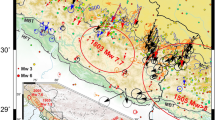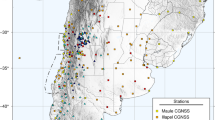Abstract
The 26th January 2001 Bhuj earthquake occurred in the Kachchh Rift Basin which has a long history of major earthquakes. Great Triangulation Survey points (GTS) were first installed in the area in 1856–60 and some of these were measured using Global Positioning System (GPS) in the months of February and July 2001. Despite uncertainties associated with repairs and possible reconstruction of points in the past century, the re-measurements reveal pre-seismic, co-seismic and post-seismic deformation related to Bhuj earthquake. More than 25 Μ-strain contraction north of the epicenter appears to have occurred in the past 140 years corresponding to a linear convergence rate of approximately 10 mm/yr across the Rann of Kachchh. Motion of a single point at Jamnagar 150 km south of the epicenter in the 4 years prior to the earthquake, and GTS-GPS displacements in Kathiawar suggests that pre-seismic strain south of the epicenter was small and differs insignificantly from that measured elsewhere in India. Of the 20 points measured within 150 km of the epicenter, 12 were made at existing GTS points which revealed epicentral displacements of up to 1 m, and strain changes exceeding 30 Μ-strain. Observed displacements are consistent with reverse co-seismic slip. Re-measurements in July 2001 of one GTS point (Hathria) and eight new points established in February reveal post-seismic deformation consistent with continued slip on the Bhuj rupture zone.
Similar content being viewed by others
References
Anatoli 2001 Rupture parameters of the 26 Jan 2001 earthquake derived from teleseismic data;EOS Transactions of the American Geophysical Union, June 2001
Bendick R, Bilham R, Fielding E, Gaur V K, Hough S, Kier G, Kulkarni M N, Martin S, Mueller K and Mukul M 2001 The January 26, 2001 “Republic Day” Earthquake, India;Seism. Res. Lett. 72(3), 328–335
Blume F 1999 Determination of source parameters of the great 1934 Nepal earthquake using historic and modern geodesy; Ph. D. Thesis, University of Colorado
Bodin P and 7 other authors, 2001 Aftershocks of the Gujarat, India, Republic Day earthquake;Abs. Seism. Res. Lett. 72 397
Burrard S G 1889 inGreat Trigonometrical Survey of India, Volume 14 (ed) W H Cole, S W Quadrilateral, prepared under the orders of H. R. Thuillier, Dehra Dun 1890
Chung W-Y and Gao H 1995 Source mechanism of the Anjar, India, earthquake of 21 July, 1956 and its seismotectonic implications for the Kutch rift basin;Tectonophysics 242 281–292
Cole W H 1890Great Trigonometrical Survey of India, Volume 14, South West Quadrilateral, Prepared under the orders of H. R. Thuillier, Dehra Dun 1890
De Graaff Hunter J 1918 The earth's axis and triangulation, professional paper 16, Survey of India, Dehra Dun., pp. 219
Gowd T N, Srirama Rao S V and Chary K B 1996 Stress field and seismicity in the Indian Shield: Effects of the collision between Indian and Eurasia;Pageoph. 146 1–27
Gulatee B L 1935 Geodetic Report of Survey of India 1934, Chapter VII, Research and Technical Notes, Dehra Dun 1935
Gulatee B L 1950 Geodetic Triangulation in Kutch;Survey of India Technical Report 1948–49, Dehra Dun 1950
Gwyn A H 1928 Leveling 1922–23, in Geodetic Report Survey of India (ed) E A Tandy1 194-286
Jade S, Mukul M, Parvez I A, Ananda M B, Kumar P D and Gaur V K 2002 Estimates of coseismic displacement and post-seismic deformation using global positioning system geodesy for the Bhuj earthquake of January 2001;Curr. Sci. 82 6, March 2002
Nagar V K and Singh A N 1992 An estimate of the vertical velocity field in India from historic leveling data, Internal report; Survey of India, Dehra Dun
Negishi H, Mori J, Sato T, Singh R, Kumar S, Hirata N 2002 Size and orientation of the fault plane for the 2001 Gujarat, India Earthquake (Mw7.7) from aftershock observations: A high stress drop event;Geophys. Res. Lett. 29 1949
Sato T and 17 other authors, A comprehensive survey of the 26th January 2001 earthquake (Mw 7.7) in the state of Gujarat, India, December 2001, 117p
Strahan G 1893 Descriptions and coordinates of the principal and secondary stations and other fixed points of the Cutch Coast Series, or Series L, of the South West Quadrilateral;Synopsis of the results of the Great Trigonometrical Survey of India 33 Dehra Dun
Survey of India 1950 Technical Report, 1948–9, Dehra Dun
Toda S, Stein R S, Reasenberg P A and Dieterich J H 1998 Stress transferred by theM w = 6.5 Kobe, Japan, Shock: Effect on aftershocks and future earthquake probabilities;J. Geophys. Res. 103 24543–24565
Thuillier H R 1894 Kathiawar Meridional Series;Synoptical Volume of the Great Trigonometrical Survey of India 34 Dehra Dun
Author information
Authors and Affiliations
Rights and permissions
About this article
Cite this article
Jade, S., Mukul, M., Parvez, I.A. et al. Pre-seismic, co-seismic and post-seismic displacements associated with the Bhuj 2001 earthquake derived from recent and historic geodetic data. J Earth Syst Sci 112, 331–345 (2003). https://doi.org/10.1007/BF02709260
Issue Date:
DOI: https://doi.org/10.1007/BF02709260




